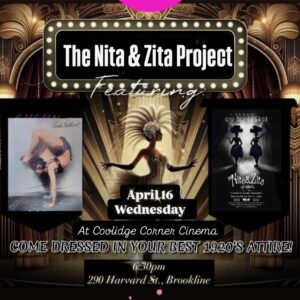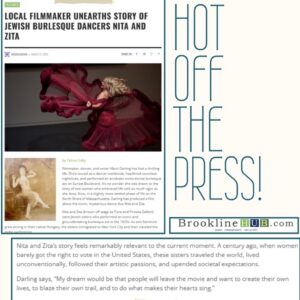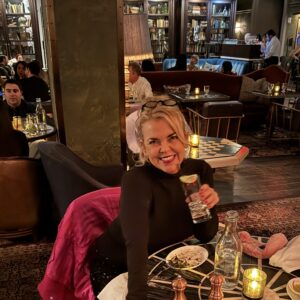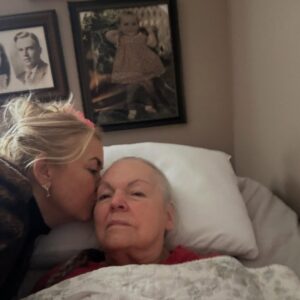Do you remember the “Wake-Up Fairy” who came around after naptime in Kindergarten to touch us gently on the head, signaling us it was time to wake up? It’s time for that Wake-Up Fairy to come back!
When I attended Kindergarten at Walt Disney Elementary in San Ramon, CA, my teacher was Mr. Finch and our wake-up fairy was a rock that was painted to look like a ladybug. my strongest memory of Mr. Finch is the thrilling wait in line for him to throw each of us up in the air and catch us on our way back down, a tumbling squealing mass of childhood. I remember baking cinnamon pretzels, sculpting playdough, and building things out of wooden towers out of wooden blocks.
When I grew up and taught preschool, I recreated my Kindergarten days for my students. We wore slippers in the classroom, baked bread twice a week, danced, played theater games, painted, sculpted, built wooden towers, and took 2-hour long walks in the woods every day. Every day after lunchtime, they would pull out their blankets and stuffed animals for rest time, which consisted of me telling them fairy tales: Three Billy Goats Gruff, The Three Bears, Jack and the Beanstalk… Then I would put the needle-felted wake-up fairy on my finger and she’d flutter around and land softly on each child’s head, telling them it was time to wake up to go back outside and play.
Now that I teach college students, guess which type of class they love the most? They just turned in their final papers reflecting on what they learned, and nearly all of them wrote about our guest speaker Katie Clarke. Katie is a theater teacher who came into our classroom and had the kids push their desks aside to play theater games. “I’m a tree. (Pose as a tree) “Come make yourself into something that would be around a tree.” Each student ran into the “scene” as a lake, a duck, a person having a picnic, a flower. While it seemed designed for young children, my college students were embarrassed at first, but then they turned exuberant, approaching each game with gusto. They reflected about how the theater games made them feel less awkward around the other students, created a community in our classroom, made them think in a more creative way, and gave them ideas for their own future classrooms. That class reminded me that Kindergarten just might be the greatest invention of the last thousand years.
Dr. Mitchel Resnick agrees. He wrote a book called “Lifelong Kindergarten: Cultivating Creativity through Projects, Passion, Peers, and Play. He found that his students were able to innovate, cultivate creativity, and enhance their learning when they were engaged in the same form of learning originally created for the very first kindergarten.
Is Mitchel Resnick a kindergarten teacher? No, he is a professor at MIT, and Director of the Lifelong Kindergarten group at the MIT Media Lab. He is also the inventor of the incredibly popular Scratch, the programming software and online community, used by millions of young people all over the world.
When he was invited to present at a professional conference on the greatest invention of the last thousand years, he nominated kindergarten. Why?
He believes humans learn best with the same approach as the original kindergarten: open ended building materials, exploring curiosity, building, failing, thinking about it, then building again. Resnick created four main points for the best way to cultivate creativity:
- Projects
- Passion
- Peers
- Play
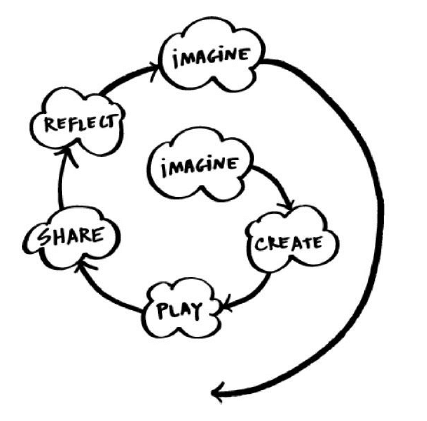
They learn to develop their own ideas, try them out, experiment with alternatives, get input from others, and generate new ideas based on their experiences.
Unfortunately, after kindergarten, most schools shift away from the Creative Learning Spiral. Students spend much of their time sitting at desks, filling out worksheets, and listening to lectures.
Resnick writes about “Student X,” a new breed of student who willing to take risks, try new things, and define their own problems outside of textbooks. These are the types of students who thrive at places like MIT, students who innovate and come up with new ideas.
Most schools place a higher priority on teaching students to follow rules and get A’s. But today’s workplace is undergoing radical transformation, and one researcher estimates that ⅔ of today’s kindergartners will end up working jobs that haven’t been invented yet.
Resnick is convinced that kindergarten-style learning is exactly what’s needed to help people of all ages develop the creative capacities needed to thrive in today’s rapidly changing society. “Educational systems have proven stubbornly resistant to change. Even as new technologies have flowed into schools, the core structures and strategies of most schools have remained largely unchanged, still stuck in an assembly-line mindset, aligned with the needs and processes of the industrial society.”
In this rapidly changing landscape, the ability to think and act creatively is more important that ever before.
What kinds of tools help develop these skills? Things like Legos, Scratch Programming, and Froebel’s Gifts. What are Froebel’s Gifts? Froebel opened the first kindergarten in Germany in 1837, and defined a new approach to learning. He believed children learn best by interacting with the world around them with open-ended toys, including blocks, colored papers, sticks, and toothpicks. Both Buckminster Fuller and Frank Lloyd Wright credited Froebel’s gifts with helping them create new forms of architecture and new inventions.
Descendants of Froebel’s Gifts are things like wooden blocks, Lego bricks and Tinkertoys. Resnick uses these items in his classes with college age students, encouraging them to build, experiment, fail, and recreate. He has found project-based learning cultivates creativity. When students are designing something meaningful, they understand the abstract concepts in more significant way.
“There is a common concern about project-based learning: it’s difficult to predict, ahead of time, exactly what students will learn as they work on projects. It could be more efficient to develop a list of concepts that are important for students to know and teach them instead. In fact, that’s the way most classrooms are organized. On the surface, this approach might seem to make sense. But when students solve sets of disconnected problems, they often end up with disconnected knowledge. The project-based approach is much different. Students encounter concepts in a meaningful context. As a result, they are better able to access and apply the knowledge in new situations.”
Projects:
“Coding is a form of fluency and expression, much like writing. When you learn to write, it’s not enough to learn spelling, grammar, and punctuation. It’s important to learn to tell stories and communicate your ideas. The same is true for coding. A project-based approach is the best path to fluency, whether for writing or coding. As you learn to code, you become a better thinker. You learn to break complex problems into simpler parts. You learn to indentify problems and debug them. You learn how to iteratively refine and improve designs over time. All these strategies are grouped under the term of computational thinking.”
Peers
Collaborate, share ideas, open sources, take other’s ideas and improve upon it… One LEGO executive once explained the reason why open innovation is a great opportunity for their company: “We’re proud of our product-development teams. But we also realize that 99.99% of the smartest people in the world don’t work for the LEGO company.”
Passion
“When students follow their curiosity, they study, explore, and work longer and harder. They persist through challenges. Too often, teachers and educational publishers try to make lessons easier, believing that children want things to be easy. But that’s not the case. Most children are willing to work hard — eager to work hard — so long as they’re excited about the things they’re working on. Seymour Papert used the term of hard fun to describe this type of learning. By the way, the effect of rewards are most negative when creative activities are involved. Intrinsic motivation and passion are the key drivers here.“
Play
- Playful in interactions
- Take risks
- Experiment
- Develop as a creative thinker
“I use the word play differently from some people. People think of fun and games — I don’t have anything against fun and games. I prefer the word playful or playfulness. I’m really trying to get at a type of approach or way of engaging that involves taking risk, experimenting, trying new things. And the environment needs to be supportive enough that it’s OK to mess up.“
So what’s the role of teachers?
“They play a role as catalysts, sparking ideas, as consultants, helping people navigate the learning process and providing new strategies to avoid frustration, as connectors to bring people together — peers who can be helpful to each other — and also as collaborators themselves. We want to blur the boundaries so teachers become learners and learners become teachers.”
I encourage all educators to allow the Wake-Up Fairy back into your classrooms. Wake up your classrooms by encouraging your students to get up out of their seats, to play, follow their passions, connect and collaborate with peers, and to allow their imaginations to soar.
And I highly recommend to all people: Allow yourself to fail. Try out thrilling new things, things that make you feel like your kindergarten teacher is throwing you in the air and catching you on the way down. Get up and move. Laugh. Embrace the awkward. Allow the gifts of kindergarten to weave themselves throughout your life so that you can approach the world with curiosity and passion. And of course, dance every day.










